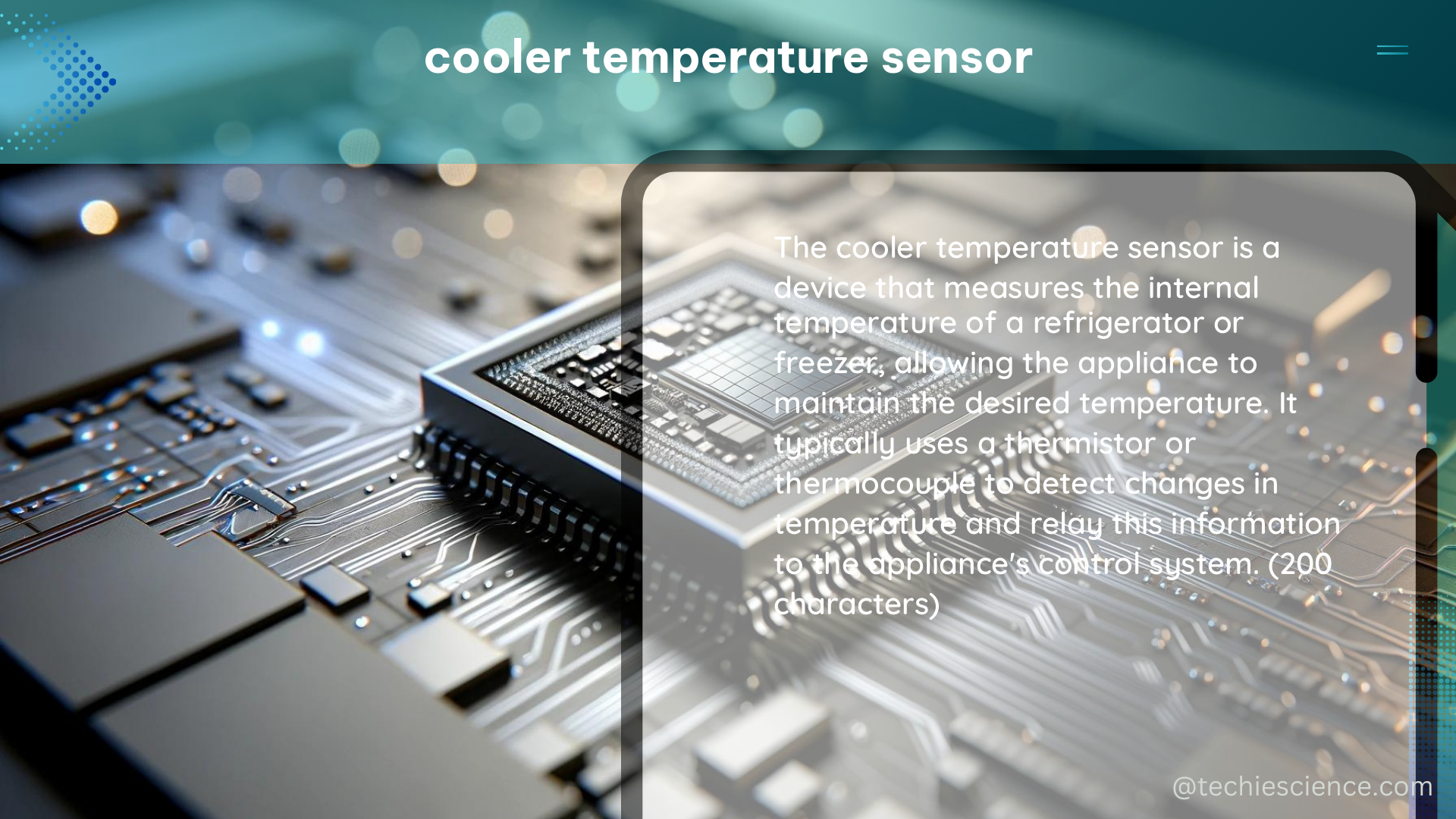Cooler temperature sensors are essential components in various systems, including air conditioning units, refrigerators, and cold storage facilities. They measure the temperature of the surrounding environment and provide feedback to the system to regulate cooling. This comprehensive guide will delve into the technical specifications of cooler temperature sensors and provide a detailed DIY guide to help you create your own sensor.
Technical Specifications of Cooler Temperature Sensors
Temperature Range
Cooler temperature sensors typically have a wide temperature range of -40°C to 125°C (-40°F to 257°F). This extensive range ensures accurate temperature measurement in various cooling applications, from deep freezers to commercial refrigeration units.
Accuracy
The accuracy of cooler temperature sensors can vary depending on the sensor type and quality. High-precision sensors can have an accuracy of ±0.1°C (±0.18°F), while standard sensors can have an accuracy of ±1°C (±1.8°F). For critical applications, such as medical storage or food processing, high-accuracy sensors are essential to maintain strict temperature control.
Response Time
The response time of a temperature sensor is the time it takes for the sensor to reach 63.2% of the change in temperature. For cooler temperature sensors, the response time is typically between 1 and 10 seconds. Faster response times are crucial in applications where rapid temperature changes need to be detected, such as in industrial refrigeration systems.
Temperature Coefficient of Resistance (TCR)
The TCR of a temperature sensor is a measure of how much the resistance of the sensor changes with temperature. A higher TCR indicates a more significant change in resistance with temperature, resulting in better sensitivity. Cooler temperature sensors often have a TCR of around 4,000 to 5,000 ppm/°C (parts per million per degree Celsius), providing excellent sensitivity for precise temperature monitoring.
Stability
The stability of a temperature sensor refers to its ability to maintain its accuracy over time. High-quality cooler temperature sensors can have a stability of ±0.1°C/year (±0.18°F/year) or better, ensuring reliable and consistent temperature readings throughout the sensor’s lifetime.
Package
Cooler temperature sensors can come in various packages, including thermistors, RTDs (Resistance Temperature Detectors), and thermocouples. The choice of package depends on the specific application requirements, such as temperature range, accuracy, and environmental conditions.
- Thermistors: Thermistors are the most common type of cooler temperature sensors due to their low cost, compact size, and high sensitivity. They are available in a wide range of resistance values, typically ranging from 2.2 kΩ to 100 kΩ at 25°C.
- RTDs: RTDs offer higher accuracy and stability compared to thermistors, making them suitable for critical applications. They are available in different materials, such as platinum (Pt100) or nickel (Ni100), with resistance values of 100 Ω or 1000 Ω at 0°C.
- Thermocouples: Thermocouples are less commonly used for cooler temperature sensing due to their lower accuracy and sensitivity compared to thermistors and RTDs. However, they are well-suited for high-temperature applications and harsh environments.
DIY Guide for Cooler Temperature Sensors

To create a simple cooler temperature sensor, you can use a thermistor, a resistor, and a microcontroller. Here’s a step-by-step guide:
Materials Needed
- Thermistor (10 kΩ at 25°C)
- 10 kΩ resistor
- Breadboard
- Jumper wires
- Microcontroller (e.g., Arduino)
Step 1: Connect the Thermistor and Resistor
Connect one end of the thermistor to a jumper wire and the other end to a breadboard. Connect one end of the 10 kΩ resistor to the same breadboard row as the thermistor’s connected jumper wire.
Step 2: Connect the Breadboard to the Microcontroller
Connect a jumper wire from the breadboard row with the thermistor and resistor to an analog input pin on the microcontroller.
Step 3: Power the Microcontroller
Power the microcontroller using a battery or USB cable.
Step 4: Program the Microcontroller
Write a program for the microcontroller to read the analog input pin’s voltage and convert it to a temperature reading. You can use the Steinhart-Hart equation to convert the resistance of the thermistor to a temperature reading:
T = 1 / (A + B*ln(R) + C*ln(R)^3) - 273.15
Where:
– T is the temperature in degrees Celsius
– R is the resistance of the thermistor in ohms
– A, B, and C are constants specific to the thermistor
The constants A, B, and C can be obtained from the thermistor’s datasheet or by performing a calibration process.
Step 5: Test the Sensor
Place the sensor in a cooler and observe the temperature reading on the microcontroller. Ensure the sensor is properly insulated from the surrounding environment to obtain accurate temperature measurements.
By following this DIY guide, you can create a simple and cost-effective cooler temperature sensor using readily available components. This sensor can be integrated into various cooling systems, such as refrigerators, air conditioners, or cold storage facilities, to provide real-time temperature monitoring and control.
Remember to consider the specific requirements of your application, such as the desired temperature range, accuracy, and response time, when selecting the appropriate components for your cooler temperature sensor.
References
- Temperature Sensor Selection Guide
- How to Build a Temperature Sensor with Arduino
- Temperature Sensor Circuit with Arduino
- Thermistor Basics and Circuits
- RTD Sensor Fundamentals
- Thermocouple Basics

The lambdageeks.com Core SME Team is a group of experienced subject matter experts from diverse scientific and technical fields including Physics, Chemistry, Technology,Electronics & Electrical Engineering, Automotive, Mechanical Engineering. Our team collaborates to create high-quality, well-researched articles on a wide range of science and technology topics for the lambdageeks.com website.
All Our Senior SME are having more than 7 Years of experience in the respective fields . They are either Working Industry Professionals or assocaited With different Universities. Refer Our Authors Page to get to know About our Core SMEs.